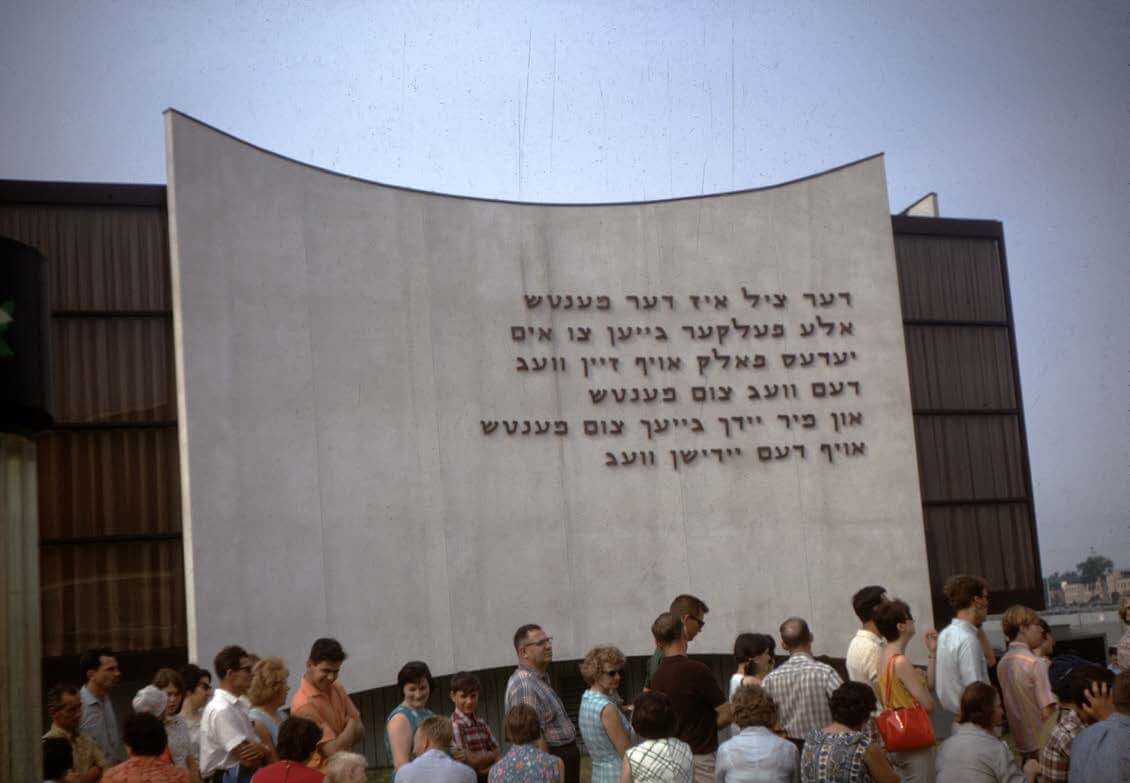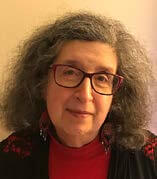Above: Ken Goldman. Jacob’s Ladder Triptych, 2015. Chromaluxe print after performance. Photos by Gideon Cohen
In 1967, my parents took me and my sisters across the Canadian border in downtown Detroit and drove us to Montreal to see the International and Universal Exposition—Expo 67. The theme of Expo 67 was “Man and His World,” inspired by Antoine de Saint-Exupéry’s book, Terre des hommes. Every country was invited to contribute a pavilion and sixty-two accepted, Israel among them.
Montreal’s Rabbi Wilfred Shuchat wanted to have a small synagogue included in the Israel Pavilion. In a decisive reply that is guaranteed to break the hearts of twenty-first-century Jews, the pavilion designers refused Rabbi Shuchat’s request on the grounds that Israel was “a modern, democratic and secular Jewish state”i that was “holy to three world religions.”ii

Courtesy of the author
Rabbi Shuchat then decided to make the synagogue freestanding, but when he turned to his wealthy congregant Sam Steinberg for funding, Steinberg insisted that the synagogue had to be part of a Pavilion of Judaism, a counterpart to the Christian Pavilion of Unity, and he got his wish. The Pavilion of Judaism, designed by Montreal architect Harry Stilman, was a graceful, understated structure. It was capped by a dome in a nod to Moorish synagogue architecture. Curved rectangular white walls, meant to evoke pages from a book or an open scroll, were affixed to the four sides of the building’s exterior. They displayed quotations in Hebrew characters, which were elegantly carved from Douglas fir, and thus it happened that Yiddish came to the Expo. One of the quotes was based on the words of Y. L. Peretz:
A rough translation of these lines might be:
The goal is humanity
All people strive for it
Each people on its own path
The path to humanity
And we Jews strive for humanity
On the Jewish path.
This universalist sentiment is actually a misleading expansion of one line that Peretz wrote as a plea to educated, secular Jews to turn their backs on assimilation and return to their people. It’s rephrased from “Home-Coming,” the second section of his piece, “Advice to the Estranged.” Solomon Liptzin translated it as: “All roads lead to the ideal man, but each people has its own specific road.”iii Peretz was over and done with the maskilic emulation of non-Jews, and that’s what he was writing about.
In the midst of all the negotiation and deliberation about the Jewish Pavilion, someone took the line from Peretz and adapted it to address the theme of “Man and His World” while avoiding any conflict between Israel and the Diaspora. Peretz himself was probably inspired by the prophet Micah: “Though all the peoples walk / Each in the names of its gods, / We will walk / In the name of the Lord our God / Forever and ever” (Micah 4:5). The story of these lines sums up the classic Jewish paradox that was at play at the Jewish pavilion.
This rich personal connection to Montreal was completely unknown to my family when we made our sojourn to Expo 67.
In 1967, Yiddish culture still existed in North American Jewish centers like Montreal and New York, but then as now, it was siloed in its own corner of Jewish society, and unlike now, it was less important to the younger generation, though Yiddish schools still operated in places like Montreal and Winnipeg. Montreal’s Jewish leaders were grappling with the substantial antisemitism that accompanied the Quebec separatist movement and they were anxious to demonstrate their loyalty as Canadians of the Mosaic faith. They were removed from the heymish world of Yiddish and, like most Expo attendees, they probably had no idea what they were seeing when they looked at the Hebrew letters. My parents, who were both children of native Yiddish speakers, could not read the Yiddish, even though my father took this picture of the wall. This wall faced a central plaza in the pavilion’s section of Expo, which might indicate that the pavilion’s designers believed in the universal theme of the Yiddish words and wanted them to be prominent as part of Expo’s theme. But that belief was lost on visitors like my Jewish parents.
In the twenty-first century, thanks to genealogical research, I’m even more personally aware of this paradox. It appears that my great-great-grandfather was the first cantor of the Rumanisher Shul in Montreal, which no longer exists. Later, he ran a Judaica bookstore on Cadieux Street, which also no longer exists, and he and my great-great-grandmother are buried in Montreal’s historic Baron de Hirsch Cemetery. This rich personal connection to Montreal was completely unknown to my family when we made our sojourn to Expo 67. Nor was I aware of the Yiddish words at Expo until I digitized a box of slides that I found among the earthly possessions of my late parents. Even then, I might have ignored it had I not undertaken the study of Yiddish in my old age.
Expo took place during the summer of Israel’s seminal victory in the 1967 Six-Day War, and that triumph came to define the North American Jewish experience. Whatever awareness North American Jews had of themselves as the descendants of Yiddish-speaking immigrants was overwhelmed by the Hebrew narrative of the modern Israeli triumph.
At the international exhibition on “Man and His World,” Jews celebrated their religion and their country, but not their peoplehood or their distinctive language. Most Jewish visitors, especially from America, were probably unaware that the Yiddish words on the wall of the Jewish pavilion reflected the universal theme of Expo 67. Along with their non-Jewish fellow fairgoers, most of them could not even read it.

Beth Dwoskin is a retired librarian and Yiddish singer who holds a master’s degree in Judaic Studies from the University of Michigan Frankel Center. She was a 2020 fellow at the Yiddish Book Center.
i H. Troper, “A Tale of Two Pavilions: Jewish Participation in Expo 67,” Canadian Jewish Studies/Etudes Juives Canadiennes 26 (2018): 162.
ii Ibid.
iii Isaac Leib Peretz, Peretz, trans. and ed. Sol Liptzin (New York: YIVO, 1947), 42–43.